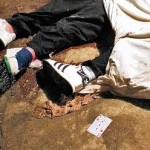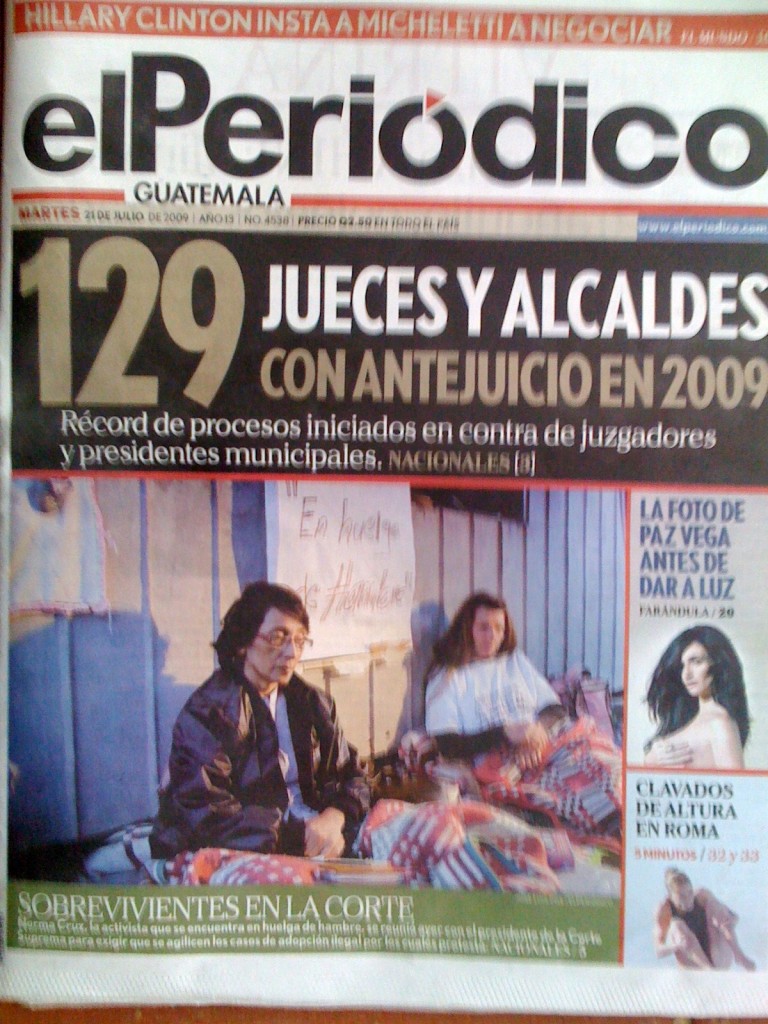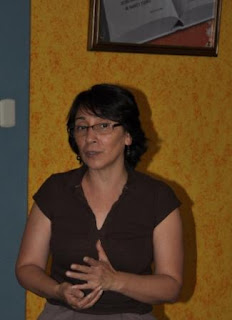
La violencia causa un promedio de 17 muertes a diario en Guatemala, uno de los índices más altos de Latinoamérica.
Por Cristina Bonillo
El conflicto armado terminó de manera oficial hace 13 años, pero solo sobre el papel, ya que las cifras de la violencia superan en la actualidad las de aquellos tiempos e impiden a la población gozar de la libertad y la seguridad propias de los países en paz.
Esto, además de los constantes cambios de autoridades en el Ministerio de Gobernación, los planes de seguridad fallidos y la falta de capacidad policial, hace que internacionalmente Guatemala sea calificada como un país altamente peligroso para nativos y turistas.
Desde 1997 —luego de la firma de los acuerdos de paz— se han producido en el país casi 60 mil asesinatos de hombres y mujeres, cifra que coloca al país en uno de los peores lugares del mundo sobre tasa de crímenes, que alcanzó en el 2008 los 48 homicidios por cada cien mil habitantes
Las cifras del conflicto hablan de 200 mil víctimas y desaparecidos, según los informes de la Comisión de Esclarecimiento Histórico (CEH) y de la Recuperación de la Memoria Histórica (Rehmi), lo que señala una media de cinco mil 500 asesinatos al año. La anual de los 13 años de paz es de algo más de cuatro mil 600 asesinatos, con una tendencia al alza, lo que no supone una gran diferencia entre la paz y la guerra
La Organización Mundial de la Salud estipula como un índice normal de criminalidad de cero a cinco homicidios por cien mil habitantes al año. Las sociedades que superan este rango se encuentran en una situación de alerta y enfrentan un problema de criminalidad epidémica que requiere un abordaje especial. “Desde el punto de vista de la salud, Guatemala está enferma”, explica Sergio Morales, procurador de los Derechos Humanos
Helen Mack, de la Fundación Myrna Mack, asegura que esta es “una guerra nueva, porque prevalece el mismo terror y las mismas características de impunidad. La corrupción se democratizó”, denuncia. “En tanto las políticas de seguridad no sean del Estado, seguiremos viendo cambios como el último del ministro de Gobernación, con el que son cuatro en un año y medio. Así es imposible avanzar, no hay continuidad”, añade.
El problema también es grave desde el punto de vista económico. Una publicación del PNUD-Guatemala en el 2006 asegura que el costo de la violencia fue de Q17.9 millones, y parece que las cantidades aumentan. Según proyecciones de expertos en criminalidad, el 2009 podría ser el año más violento desde la firma de la paz, puesto que debido al ritmo actual, habrá más de siete mil homicidios, con lo cual se superarán las 17 muertes violentas diarias en promedio de la actualidad, cifra inédita hasta ahora en el país
Esta situación ha propiciado que Guatemala se encuentre en uno de los últimos lugares del Índice Global de Paz 2009, en el que se miden varios criterios para determinar el nivel de concordia en el que vive un país
Entre éstos están los altos niveles de criminalidad, el alto índice de homicidios por habitante, la facilidad para poseer un arma y la falta de respeto por los derechos humanos. La conflictividad social causa que los niveles de violencia anual recuerden los de una guerra convencional
Sandino Asturias, analista del Centro de Estudios de Guatemala, explica: “La violencia del pasado —guerra civil— fundamentalmente era una política de Estado, por lo cual se instauró todo un mecanismo de impunidad total que se mantiene en la actualidad. Si se hubieran corregido los excesos, hoy no tendríamos los niveles de violencia que tenemos”
La CEH identificó en su informe de 1999 sobre el conflicto las causas que lo generaron, las cuales aún perviven en la sociedad guatemalteca, de acuerdo con estudios actuales efectuados por entidades nacionales e internacionales; por ejemplo, el racismo, la desigualdad extrema y un sistema imperante de injusticia institucional
Otro factor importante en la continuidad de la violencia es la gran cantidad de armas que circula en el país. El Departamento de Control de Armas y Municiones (Decam) tiene registro de tenencia de 375 mil armas de todo tipo, pero diversas organizaciones creen que hay al menos 500 mil más en posesión ilegal
De acuerdo con Asturias, en 1997 se vendieron 21 millones de municiones legalmente en el país. En el 2008, en lugar de reducirse esta cantidad, la cifra de municiones vendidas superó los 50 millones para consumo interno. “Si vienes de un país en conflicto, con una justicia débil y además has permitido que la gente se arme, que la criminalidad esté mejor armada que las fuerzas de seguridad, las armas se convierten en el mecanismo de confrontación y resolución de conflictos”, refiere
El auge del negocio de las armas se refleja en las cifras de la violencia: en 1997, el 40 por ciento de los homicidios se producía con arma de fuego. En el 2008, la cantidad de asesinatos cometidos por este medio superaba el 85 por ciento.
Cultura de la impunidad
El 98 por ciento de los delitos que se cometen en el país queda en la impunidad. “Tenemos problemas irresueltos. No se ha logrado obtener un modelo de desarrollo económico y social justo y equilibrado, el fondo de todo tiene que ver con la desigualdad y la injusticia”, expone la diputada Nineth Montenegro.
La aparición de nuevos fenómenos, como el narcotráfico, el crimen organizado y la corrupción, ayuda a mantener el sistema de impunidad en el país. “Guatemala tiene que entrar en serio a librar una batalla frontal en sus diversos fenómenos de crimen organizado, desde el Estado, pero no se ha visto voluntad política para erradicar ese cáncer que se está comiendo el país”, critica Montenegro.
“Si el Estado no desarrolla mecanismos para corregir estas conductas, entonces éstas se mantienen en el tiempo. Se mata, porque no pasará nada”, opina el analista político Sandino Asturias.
¿A quiénes asesinan?
Uno de los aspectos que ha cambiado en relación con la época del conflicto armado es las víctimas de la violencia.
En aquel momento, la violencia estaba focalizada en los grupos opositores y tenía tintes políticos, pero hoy en día se ha generalizado, y los grupos de población más afectados son los jóvenes y las mujeres. Según datos de la Policía Nacional Civil y la Procuraduría de los Derechos Humanos, en el 54.24 por ciento de los homicidios cometidos las víctimas fueron jóvenes de 16 a 30 años, y el 10.91 por ciento fue mujeres. Los más de los expertos aseguran que residir en Guatemala es hoy mucho más peligroso y difícil que antaño.
De la misma opinión es Raquel Zelaya, de la Asociación de Investigación y Estudios Sociales (Asies). “Hay todo tipo de manifestaciones de peligro para la ciudadanía, y por encima de todo está la percepción, nos sentimos inseguros”, sentencia.
Postura: Tema pendiente
Raquel Zelaya, firmante de los acuerdos de paz e integrante de la Asies, señala que “los primeros temas que no se han cumplido de lo firmado en los acuerdos giran en torno a lo institucional: lo primero es la Policía Nacional Civil, que no es la institución que se incluyó en la firma”.
En el tema legislativo, Zelaya señala que una de las necesidades estriba en la reforma a la Ley de Orden Público, que aún tiene tintes de “autoritarismo”.
Otro punto es la regulación y control de los servicios privados de seguridad.
“Financiar un Estado contrainsurgente es mucho más barato que financiar un Estado democrático, que viene con sus instituciones; ahí estamos sumamente mal”, refiere.
Acerca de las cifras de la violencia, Zelaya expone que no solo se asemejan a las de un conflicto, sino que también son “las de un Estado cuyas instituciones de justicia están dando señales de mucha impunidad”.
OPINIONES
Nineth Montenegro: Diferencias y similitudes
“Antes sabíamos quién nos perseguía y por qué; ahora no sabemos de dónde va a llegar la bala, ni siquiera los motivos”, declara la diputada de Encuentro por Guatemala Nineth Montenegro, quien afirma que, aunque la situación es distinta porque obviamente se eliminó el tinte político de la persecución, hay similitudes en el peligro que persiste para el ciudadano.
Sandino Asturias: Nuevos enemigos
Según Sandino Asturias, del Centro de Estudios de Guatemala, ha cambiado el enemigo, que hoy “son las maras, los jóvenes en riesgo”, pero lo que prevalece es la mentalidad y “el pensamiento de que para acabar con el conflicto debe hacerse de manera represiva, en lugar de preventiva”.
Sergio Morales: Crueldad
El procurador de los Derechos Humanos opina que nos encaminamos hacia el año más violento en el país, y no solo en la cuestión de cifras. “Estos números demuestran la gravedad de la situación, pero es cualitativamente terrible, porque las crueldad con que se mata es terrible”, constató el magistrado de Conciencia.
DATOS
Las cifras del conflicto armado
El número de víctimas que causó el conflicto armado interno en Guatemala no se conoce con exactitud, pero las estimaciones de la Comisión Interamericana de Derechos Humanos (CIDH) indican que fueron 200 mil durante la guerra que se extendió desde 1960 a 1996. El 83.3 por ciento pertenecía a las etnias indígenas del país.
El informe de la CEH detalló 626 masacres e identificó los años de 1978 a 1983 como los más sangrientos.
Se documentaron 42 mil víctimas, aunque existió un subregistro, porque fue elaborado de 1996 a 1999, cuando el conflicto estaba muy reciente, por lo que muchas personas no se atrevieron a hablar.
Este estudio atribuyó al Ejército el 94.8 por ciento de las matanzas, y a la guerrilla el 5.11 por ciento.
Entre las principales causas que motivaron el conflicto, la CEH citó injusticia estructural, cierre de espacios políticos, racismo, institucionalidad excluyente y antidemocrática y falta de voluntad de impulsar reformas sociales que redujeran los conflictos estructurales.
http://www.prensalibre.com/pl/2009/julio/12/322470.html







 Malnutrition is an underlying cause in more than half of the 25,000 daily, preventable deaths of children.
Malnutrition is an underlying cause in more than half of the 25,000 daily, preventable deaths of children.





 Proud Founder Member of the Guatemala Peace and Development Network
Proud Founder Member of the Guatemala Peace and Development Network